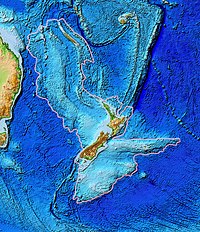
Photo from wikipedia
Abstract Understanding the interactive effects of fragmentation and invasive species on forest dynamics requires a long-term perspective because they are difficult to assess in the medium- to long-term using observational… Click to show full abstract
Abstract Understanding the interactive effects of fragmentation and invasive species on forest dynamics requires a long-term perspective because they are difficult to assess in the medium- to long-term using observational or experimental data alone. In such settings ecological models have an important role to play. Here we describe the implementation of a spatially explicit individual-based model (SEIBM) representing the dynamics of small forest fragments in northern New Zealand based on empirical data collected in the region. In addition, we performed a baseline analysis to determine how well the model captured podocarp-tawa forest dynamics, and compared its performance with stand structure data obtained from an unfragmented forest in northern New Zealand. We used sensitivity analysis to determine how sensitive the model was to changes in the input parameters. In addition, we simulated different scenarios under diverse management conditions to explore the model’s potential as a management tool. The model captures the stand structural characteristics of the fragments reasonably well but under-predicts stand basal area, suggesting that it does not represent the long-term suppression of some canopy tree species adequately. Although some refinement is needed to improve its performance, we believe that the model presented here is a useful tool for management purposes and for the assessment of the long term viability of forest fragments. The model can help inform managers and decision-makers regarding the long-term persistence of podocarp-tawa forest patches.
Journal Title: Ecological Modelling
Year Published: 2017
Link to full text (if available)
Share on Social Media: Sign Up to like & get
recommendations!